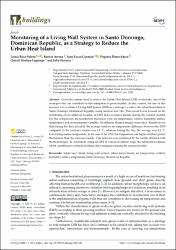Mostrar el registro sencillo del ítem
Monitoring of a living wall system in Santo Domingo, Dominican Republic, as a strategy to reduce the Urban Heat Island
| Licencia | This article is an open access article distributed under the terms and conditions of the Creative Commons Attribution (CC BY) license | es |
| Autor | Ruiz-Valero, Letzai | |
| Autor | Arranz, Beatriz | |
| Autor | Faxas-Guzmán, Juan | |
| Autor | Flores-Sasso, Virginia | |
| Autor | Medina-Lagrange, Orisell | |
| Autor | Ferreira, Julio | |
| Fecha de admisión | 2025-02-20T00:06:38Z | |
| Fecha disponible | 2025-02-20T00:06:38Z | |
| Año | 2023 | |
| Citación | Ruiz-Valero, L., Arranz, B., Faxas-Guzmán, J., Flores-Sasso, V., Medina-Lagrange, O., & Ferreira, J. (2023). Monitoring of a living wall system in Santo Domingo, Dominican Republic, as a strategy to reduce the Urban Heat Island. Buildings, 13(5), 1222. Recuperado de: | es |
| URI | https://bvearmb.do/handle/123456789/5834 | |
| Sinopsis | Given the current need to reduce the Urban Heat Island (UHI) worldwide, one of the strategies that can contribute to this mitigation is green façades. In this context, the aim of this research is to evaluate a Living Wall System (LWS) as a strategy to reduce the urban heat island in Santo Domingo, Dominican Republic, using outdoor test cells. This research was focused on the monitoring of two different façades, an LWS and a reference façade, during the warmer months. For the comparison, the parameters measured were air temperature, relative humidity, surface temperature and environmental variables. In addition, thermal images were taken. Results reveal that during the days selected, the average outdoor air temperature difference between the LWS compared to the reference façade was 5.3 °C, whereas during the day, the average was 3.3 °C. Concerning surface temperature, in the case of the LWS, the temperature was higher and had greater fluctuations than the reference façade. This behavior was confirmed by the results obtained with thermal images. In conclusion, using an LWS in a tropical climate helps the urban microclimate, which contributes to urban heat island effect mitigation during the warmer months. | es |
| Idioma | English | es |
| Publicado | Buildings, 13(5), 1222 | es |
| Derechos | © 2023 by the authors. Licensee MDPI, Basel, Switzerland. | es |
| URI de derechos | https://creativecommons.org/licenses/by/4.0/ | es |
| Materia | Ciudades sostenibles | es |
| Materia | Energías renovables | es |
| Materia | Tecnología | es |
| Título | Monitoring of a living wall system in Santo Domingo, Dominican Republic, as a strategy to reduce the Urban Heat Island | es |
| dc.identifier.doi | https://doi.org/10.3390/buildings13051222 | |
| Tipo de material | Article | es |
| Tipo de contenido | Scientific research | es |
| Acceso | Open | es |
| Audiencia | Technicians, professionals and scientists | es |
Ficheros en el ítem
Este ítem aparece en la(s) siguiente(s) colección(es)
-
Investigación ambiental [1759]


